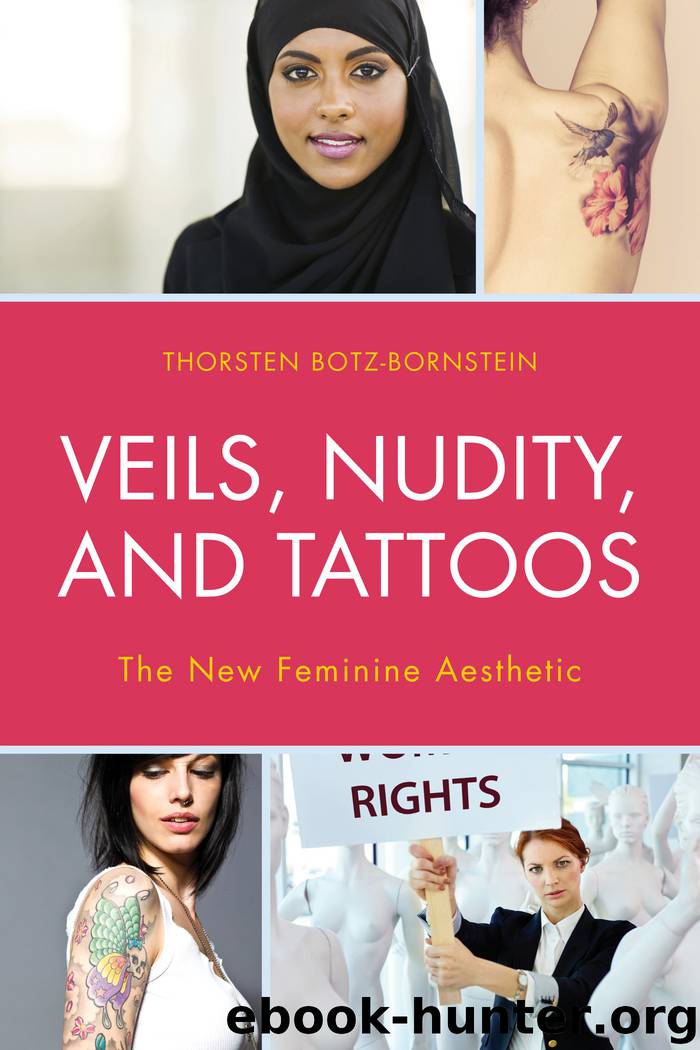Veils, Nudity, and Tattoos by Thorsten Botz-Bornstein

Author:Thorsten Botz-Bornstein
Language: eng
Format: epub
Tags: undefined
Publisher: Lexington Books
Published: 2012-03-01T16:00:00+00:00
Two Kinds of Segregation
The cool mask is not only about attitude but also about space: It becomes a means of creating and manipulating social space in order to create (ambiguous) instances of proximity and distance. There is an interesting similarity between the African American creation of “cool” behavior and veiling in Muslim contexts: both can be traced to an act of segregation. Also, in the Muslim world, the veil developed out of the ambition to segregate two kinds of human beings: men and women. Like black people in America, women in Muslim societies have often been left out of the larger picture of society and have been defined as mentally and morally inferior. Like the black man in American society, women in Muslim societies were often not recognized as equal human beings. Men usually “define the public world as their own space, [and] women are considered intruders in it. Harassment of women in the street exemplifies men’s attempt to reaffirm their own boundaries of space and identity,” write Pat Mule and Diane Barthel about Muslim societies in general (1992: 328). With the veil, however, women who had otherwise been confined to their homes can participate in social and professional activities. The veil allows “women to work while they still claim traditional respect” (El Guindi 1999: 163). Like the cool pose for black men, the veil “has helped, in a convoluted way, to carve a new space that Muslim women are using as a means of redefining the terms of their presence in public space,” writes Ziba Mir-Hosseini about women in post-revolutionary Iran (2007). Also for El Guindi, a certain power of emancipation remains a characteristic intrinsic to the veil, a fact that she believes to be valid for all Muslim societies: “Veiling also symbolizes an element of power and autonomy and functions as a vehicle of resistance” (El Guindi 1999: xvii). Like the cool mask, the veil can yield empowerment to an oppressed group; and like those American blacks mentioned above, Muslim women could obtain unofficial power within a situation that had officially declared them inferior. Mule and Barthel hold that the veil “reflects women’s efforts to gain or maintain esteem within a patriarchal society in which possibilities for autonomy are exceptionally, and increasingly, limited” (1992: 324).
The American racial situation and the practice of veiling show concrete points of connection in many instances. The most obvious instance is the use of the veil by the Nation of Islam, which has been pointed out as a facilitator of cultural identity similar to the cool mask. According to Miriam Cooke, the Nation of Islam’s khimar (veil) “symbolizes their freedom and social worth in a community that valued its women and rejected their previous sexual objectification under slavery” (Cooke 2000: 132). Jamillah Karim reports of the Nation’s practice of protecting women’s bodies from the male gaze as an act of honoring one’s natural beauty as a black woman, and that it taught the young woman Majorie “to love her blackness” (Karim 2006: 24).
The
Download
This site does not store any files on its server. We only index and link to content provided by other sites. Please contact the content providers to delete copyright contents if any and email us, we'll remove relevant links or contents immediately.
China Rich Girlfriend by Kwan Kevin(4283)
The Curated Closet by Anuschka Rees(2800)
How to Make Your Own Soap by Sally Hornsey(2739)
The Wardrobe Wakeup by Lois Joy Johnson(2632)
Tattoo Art by Doralba Picerno(2484)
Bossypants by Tina Fey(2373)
Beard by Rainwaters Matthew(1912)
The Little Book of Lykke by Meik Wiking(1896)
Life of Elizabeth I by Alison Weir(1881)
How to Be a Bad Bitch by Amber Rose(1880)
The Apron Book by EllynAnne Geisel(1876)
Worn in New York by Emily Spivack(1836)
The Finnish Way by Katja Pantzar(1803)
Perfume by Jean-Claude Ellena(1733)
Beauty Sick by Renee Engeln PhD(1727)
GQ How to Win at Life by Charlie Burton(1646)
Younger Skin Starts in the Gut by Nigma Talib(1628)
Lagom by Niki Brantmark(1599)
GQ How to Win at Life: The expert guide to excelling at everything you do by Burton Charlie(1586)
